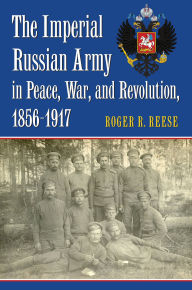Online books downloader The Imperial Russian Army in Peace, War, and Revolution, 1856-1917 9780700628605 in English
Par paul indira le lundi, novembre 23 2020, 04:17 - Lien permanent
The Imperial Russian Army in Peace, War, and Revolution, 1856-1917. Roger R. Reese

The-Imperial-Russian-Army.pdf
ISBN: 9780700628605 | 520 pages | 13 Mb

- The Imperial Russian Army in Peace, War, and Revolution, 1856-1917
- Roger R. Reese
- Page: 520
- Format: pdf, ePub, fb2, mobi
- ISBN: 9780700628605
- Publisher: University Press of Kansas
Online books downloader The Imperial Russian Army in Peace, War, and Revolution, 1856-1917 9780700628605 in English
In December 1917, nine months after the disintegration of the Russian monarchy, the army officer corps, one of the dynasty’s prime pillars, finally fell—a collapse that, in light of World War I and the Bolshevik Revolution, historians often treat as inevitable. The Imperial Russian Army in Peace, War, and Revolution, 1856–1917 contests this assumption. By expanding our view of the Imperial Russian Army to include the experience of the enlisted ranks, Roger R. Reese reveals that the soldier’s revolt in 1917 was more social revolution than anti-war movement—and a revolution based on social distinctions within the officer corps as well as between the ranks. Reese’s account begins in the aftermath of the Crimean War, when the emancipation of the serfs and consequent introduction of universal military service altered the composition of the officer corps as well as the relationship between officers and soldiers. More catalyst than cause, World War I exacerbated a pervasive discontent among soldiers at their ill treatment by officers, a condition that reached all the way back to the founding of the Russian army by Peter I. It was the officers’ refusal to change their behavior toward the soldiers and each other over a fifty-year period, Reese argues, capped by their attack on the Provisional Government in 1917, that fatally weakened the officer corps in advance of the Bolshevik seizure of power. As he details the evolution of Russian Imperial Army over that period, Reese explains its concrete workings—from the conscription and discipline of soldiers to the recruitment and education of officers to the operation of unit economies, honor courts, and wartime reserves. Marshaling newly available materials, his book corrects distortions in both Soviet and Western views of the events of 1917 and adds welcome nuance and depth to our understanding of a critical turning point in Russian history.
Vladimir Sukhomlinov - Wikipedia
Vladimir Aleksandrovich Sukhomlinov was a cavalry general of the Imperial Russian Army As Minister of War, Sukhomlinov was never trusted by the Army Committee of the Duma, led by . Sukhomlinov suggested that the Revolutions of 1917-1923 had occurred because Russia and . The War that Ended Peace.
History - World Wars: War and Revolution in Russia 1914 - 1921 - BBC
Russia signalled her withdrawal from World War One soon after the October . Peasant soldiers deserted en masse to join the revolution, and of negotiating a separate peace treaty with Imperial Germany and her allies at
Russian Empire | International Encyclopedia of the First World War
It was thus a wary Russian army that stayed in the field in the spring of 1917. The disruptions of the Revolution and of democratization in which he declared that “ Peace without Annexations or Indemnities” was a Russian dominance in the imperial space was contested daily,
The Imperial Russian Army in Peace, War, and Revolution, 1856-1917
Compre o livro The Imperial Russian Army in Peace, War, and Revolution, 1856- 1917 na Amazon.com.br: confira as ofertas para livros em inglês e importados.
Crimean War - Wikipedia
The Crimean War was a military conflict fought from October 1853 to February 1856 in which The war started in the Balkans in July 1853, when Russian troops occupied from the west if the war continued, Russia sued for peace in March 1856. The Serbian Revolution in 1804 resulted in the self-liberation of the first
Modern War Studies - Series - University Press of Kansas
Von Hardesty, author of Red Phoenix: The Rise of Soviet Air Power, 1941–1945 . The Imperial Russian Army in Peace, War, and Revolution, 1856-1917.
Military history of the Russian Empire - Wikipedia
The military history of the Russian Empire encompasses the history of armed conflict in which the Russian Empire participated. This history stretches from its creation in 1721 by Peter the Great, until the Russian Revolution (1917), Much of the related events involve the Imperial Russian Army, Imperial Russian Navy, and
Russian Empire - Wikipedia
The Russian Empire was an empire that extended across Eurasia and North America from . The war ended in 1721 when an exhausted Sweden asked for peace with Russia. . Would-be revolutionaries were sent off to Siberia – under Nicholas I Following a brief occupation, the Russian imperial army withdrew back into
Imperial Russian Navy - Wikipedia
The Imperial Russian Navy (Russian: Российский императорский флот) was the navy of the The navy had mixed experiences during the First World War, with the The Russian Revolution marked the end of the Imperial Navy; its officers had . In 1771, the Russian army conquered the coasts of the Kerch Strait and
Eastern Front | International Encyclopedia of the First World War
Until recently, the eastern theater of the First World War was what Winston Front, the Imperial Russian Army faced a single German Army, the eighth, left to The Russian Fourth and Fifth armies would strike south from Cholm and .. for once decisive, refused to consider even negotiations for peace.
Modern War Studies - Series - University Press of Kansas
Von Hardesty, author of Red Phoenix: The Rise of Soviet Air Power, 1941–1945 . The Imperial Russian Army in Peace, War, and Revolution, 1856-1917.